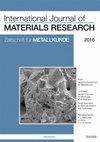The influence of microstructural orientation on fracture toughness in (V, Al)N and (V, Al)(O, N) coatings as measured by microcantilever bending
IF 0.7
4区 材料科学
Q4 METALLURGY & METALLURGICAL ENGINEERING
引用次数: 0
Abstract
Since protective transition metal (oxy)nitride coatings are widely used, understanding of the mechanisms linking microstructure to their fracture behaviour is required to optimise wear resistance, while maintaining fracture toughness. To assess this interconnection, beam bending was performed using microcantilevers oriented parallel and at 90° to the growth direction. Furthermore, the tests were applied to favour normal bending and shear fracture. Coatings were synthesised by both direct current magnetron sputtering (DCMS) as well as high power pulsed magnetron sputtering (HPPMS). Here, we show that the fracture toughness depends on the alignment of the grains and loading directions. Furthermore, an improved fracture toughness was found in coatings produced by HPPMS, when microstructural defects, such as underdense regions in DCMS deposited coatings can be excluded. We propose indices based on fracture and mechanical properties to rank those coatings. Here, the HPPMS deposited oxynitride showed the best combination of mechanical properties and fracture toughness. Principle of measuring the effects of microstructure and process route on the fracture toughness via microcantilever bending.用微悬臂弯曲法测定了(V, Al)N和(V, Al)(O, N)涂层的显微组织取向对断裂韧性的影响
由于保护过渡金属(氧)氮化涂层被广泛使用,因此需要了解微观结构与其断裂行为之间的联系机制,以优化耐磨性,同时保持断裂韧性。为了评估这种互连,使用平行于生长方向90°的微悬臂梁进行梁弯曲。此外,试验适用于正常弯曲和剪切断裂。采用直流磁控溅射(DCMS)和高功率脉冲磁控溅射(HPPMS)制备了涂层。在这里,我们表明断裂韧性取决于晶粒的排列和加载方向。此外,HPPMS制备的涂层的断裂韧性得到了提高,当微观结构缺陷,如DCMS沉积涂层中的欠致密区可以被排除时。我们提出了基于断裂性能和力学性能的指标来对这些涂层进行排名。在此,HPPMS沉积的氮化氧表现出最佳的力学性能和断裂韧性组合。显微组织和工艺路线对微悬臂弯曲断裂韧性影响的测量原理。
本文章由计算机程序翻译,如有差异,请以英文原文为准。
求助全文
约1分钟内获得全文
求助全文
来源期刊
CiteScore
1.30
自引率
12.50%
发文量
119
审稿时长
6.4 months
期刊介绍:
The International Journal of Materials Research (IJMR) publishes original high quality experimental and theoretical papers and reviews on basic and applied research in the field of materials science and engineering, with focus on synthesis, processing, constitution, and properties of all classes of materials. Particular emphasis is placed on microstructural design, phase relations, computational thermodynamics, and kinetics at the nano to macro scale. Contributions may also focus on progress in advanced characterization techniques. All articles are subject to thorough, independent peer review.

 求助内容:
求助内容: 应助结果提醒方式:
应助结果提醒方式:


